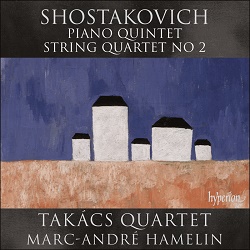
|
Dmitri SHOSTAKOVICH (1906-1975)
String Quartet No. 2 in A major, Op. 68 (1944) [35:10]
Piano Quintet in G minor, Op. 57 (1940) [35:14]
Marc-André Hamelin (piano)
Takács Quartet (Edward Dusinberre (violin); Károly Schranz (violin); Geraldine Walther (viola); András Fejér (cello))
rec. Concert Hall, Wyastone Estate, Monmouth, UK, 2014. DDD
HYPERION CDA67987 [70:26]
I have tended to associate the Takács Quartet with Beethoven and
with such Romantic composers as Schubert, Brahms, and Dvořák.
They also made highly regarded recordings of the Bartók quartets,
as did the Emersons. The latter contributed an award-winning set of
the Shostakovich works in this genre, and I am wondering whether the
Takács are about to embark on a similar journey. If so, they are getting
off to a very good start here. Like the Borodin Quartet (Melodiya/BMG),
which has been and continues to be my yardstick by which to judge
these works, the Takács have also included the popular Piano Quintet.
Geoffrey Molyneux found much to praise in these new performances,
as I do, and he designated this disc a “Record of the Month”.
In the Second Quartet, a much more substantial piece than its lighter
and simpler predecessor, the Takács find a great variety of dynamics
and articulation. I was particularly impressed with their accented
notes in the first movement. The Borodins generally play with a greater
level of intensity that can seem relentless, whereas the Takács bring
out a multitude of colours from the score. Surely some of this intensity
on the part of the Borodins is due to the close recorded sound, while
the more distant perspective provided for the Takács can be more pleasing
on the ear. The pizzicato plunks in the second movement as played
by the Borodins will lift you out of your seat, while the more discreet
ones by the Takács are effective enough. Both quartets excel in the
shadowy waltz of the third movement, even if the Takács are even better
in portraying the mystery of this fantastic music. In the final Theme
and Variations, the Borodin’s fulsome sound is a definite advantage.
They perform with power and eloquence, and their rendering of the
folksong-like theme is quite beautiful as is the hymn-like passage
later in the movement. The Takács with lower voltage are still mightily
effective in this movement, as they are throughout the quartet. Both
performances have much to offer and I would not want to be without
either.
The Piano Quintet, one of my favourite Shostakovich scores, has received
a number of excellent recorded performances over the years; none more
so than Sviatoslav Richter’s live account with the Borodin Quartet
in the same set as the string quartets. If any pianist could challenge
Richter it would be Marc-André Hamelin, for his is the best performance
of the quintet I’ve heard since Richter’s. Like their
performance of the quartet, the Borodins are very intense in the first
movement. The improvement in the recording in this new account is
evident from Hamelin’s first chords. The sound is strong, but
not harsh and the balance with the strings is exemplary. It may not
be as overwhelming as Richter and the Borodins, but it is as convincing
on its own terms.
The Borodins slim down their tone for the poignant theme of the second
movement and capture its mood with perfection. I have often thought
how close this theme sounds to that of the first movement of Górecki’s
Third Symphony. The Polish composer surely had this in mind when he
composed his work. The sadness of this melody is also captured well
by the Takács, even if their warmer, sweeter sound may be less effective.
As the music becomes agitated, the performers heat up accordingly
and allow for some imperfect intonation that actually adds to their
interpretation. At the same time, the Borodins reach a level of vehemence
that is all but unbearable. It’s hard for me to imagine it better
played.
In the third movement Scherzo the Borodins are deliberate
and heavy, with substantial portamento to emphasize the sardonic
nature of the music. The Takács take a significantly faster tempo,
and Hamelin handles the difficult piano part with aplomb. It’s
an amazing performance, even though it lacks some of the character
of the Borodins. With its closer recording, the Borodins’ cello
pizzicati are emphatic, while the Takács are more withdrawn. Their
upper strings are eloquent and warm with a judicious employment of
vibrato, and the piano enters with a clear, bell-like tone. It contrasts
to the harder sound of Richter’s piano in the closer Borodin
recording. This neo-Baroque aria over a “walking bass”
is very moving in the Takács account, even if it is not as bold as
the Borodin’s.
The finale is one of those Shostakovich movements acting as a release
after all of the tension built up earlier. I have to say that I love
it and find it a creative and convincing way to end the quintet. Here
the Borodins lighten up, so their performance comes like a breath
of fresh air. One notices a warmth that seemed lacking elsewhere and
they end the work, with its portamenti, simply and beautifully.
The Takács are slightly more deliberate, but they build the climax
unerringly and the blend with the piano is really good. The release
from what has preceded it is not as apparent with the Takács as it
was with the Borodins simply because they had not attained the same
level of tension earlier.
I am very happy to have heard these performances and know I shall
return to them again. If I still have a special fondness for the Borodin
Quartet, I can safely add the Takács for a different view of these
works. I hope they will continue with a complete series of the Shostakovich
quartets.
Leslie Wright
Previous review: Geoffrey
Molyneux (Recording of the Month)
 |
 |
|
